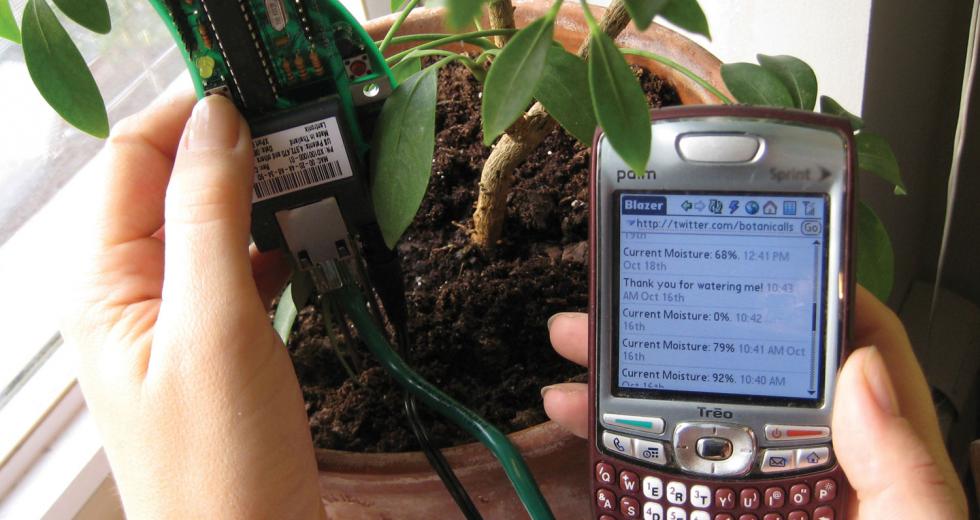Try as they might, some people are incapable of keeping a plant alive. As easy as maintaining a regular watering schedule, proper lighting and keeping pests away seems, these black thumbs, as they’ve been termed, can still turn the hardiest species into compost after a few weeks.
Two recent gadgets give a leg up to gardeners who can’t quite get the swing and — much in the fashion of the Ambient Orb (Comstock’s, January 2008) — offer a chance to bring the power of networks and databases to everyday life.
The first gardener’s helper is the EasyBloom (easybloom.com) from PlantSense Inc., a three-year-old startup from San Francisco. The $59.95 device is built to look like a flower: white with green tines that stick into the earth and light-green petals.
Users stick the tines into a plant pot where the device collects data, such as moisture level and solar exposure. The top of the flower comes off and goes into a computer’s USB port. Then the user receives customized plant recommendations, which are sorted by color and variety, among other factors. In monitor mode, EasyBloom stays with the plant to diagnose over and under watering, and lack of light.
The venture began after PlantSense’s CEO Matthew Glenn was getting his hair cut and heard his stylist’s tale of woe: Her plants, despite being in a well-lit place, didn’t live very long. Glenn, who sold his previous company to Cisco for $450 million in 2005, looked around for a technical solution. It led him, strangely, down the same path as NASA. Soon, Glenn and PlantSense wound up using solutions the space agency used for the Mars rover to help the EasyBloom gather information on where plants reside. The company announced last summer it had secured $3.5 million in funding from Gabriel Venture Partners as well as angel investors.
Part of EasyBloom’s success comes in marrying the technical readings with an easy-to-use back end, which is the Web component that suggests plants for that window box in the backyard where nothing seems to grow. While the Easy-Bloom doesn’t measure more complicated elements such as soil alkalinity or nutrient levels, it is able to help novice gardeners understand the fundamental concepts of shading and how different locations can impact growth.
According to Randy Aspinall, department manager at Emigh Ace Hardware on El Camino Avenue in Sacramento, the EasyBloom has yet to catch on. Aspinall’s store has only sold four of the twelve units it’s stocked, despite employees being excited about the product. Customers arrive every day with plant woes, but they’re not sold on an electronic solution just yet. “I think it has great possibilities; people are just somewhat hesitant,” Aspinall says.
Aspinall is considering making one of the EasyBlooms available for customers to test in their own gardens. “It’s going to take a little while before people catch on to it. We really thought about taking one, writing it off, hooking it up to our computer and loaning it out,” he says.
Although EasyBloom’s analysis and matching is what counts, Botanicalls is all about notification and the plant reaching out to the owner when it needs attention. Botanicalls started at New York University’s Interactive Telecommunications Program, or ITP, in December 2006.
“We brought in plants from all over and made custom setups for them and sensors that were looking for light and water,” says Kati London, part of the ITP group that created Botanicalls. “We created personalities based on the different botanical characteristics and habits.”
When the sensor detected low water, the plants would speak up (Really, data would be sent via open-source telephony service.) and call a phone in the lounge, each with a distinct voice based on the plant’s region of origin or other traits.
“You’d get a visual indicator as well as the voice call, so in addition to the name you’d get a plant number. [Students] could identify which one it was, take care of it and get feedback. So there was learning that was happening in the process. Everybody wanted one who saw it, so we made kits.” A leaf-shaped circuit board sits on two sensor rods and plugs into both a home network and power outlet.
The Botanicalls process evolved away from the phone, according to London, and onto Twitter as a means for the plants to communicate. Twitter is a service that allows users to send messages with fewer than 140 characters to one another, and follow their friends (or, in this case, plants) to see what’s happening. Each $99.95 kit is given a specific user identification linked to Twitter. The sensor sends out periodic Twitter updates (twitter.com/botanicalls) with its moisture level (“URGENT! Water me!”), which users can have delivered to a mobile phone or the Web, as well as a blinking light when it needs a drink. The system even sends a thank you when the plant is watered.
Compared to EasyBloom, Botanicalls is more apt for a hobbyist — the kit requires some basic soldering — and a better aptitude for following instructions. Additionally, if users want to customize the moisture range away from the default value, say, for a plant that thrives in wet soil, the unit needs reprogramming.
London says not only is it interesting to see more tech-inclined people minding their plants, but also to think about the deeper interactions going on when we give plants a way to communicate.
“There are hundreds of people following plants on Twitter, plants following plants,” London says. “We’re interested to see what emerges socially out of that. Is there a way for plants toâ?¨share information or aggregate data over time? That’s the bigger goal. How do you use human communication protocols for nonhuman communication?”
So, have these new observational technologies impacted the gardening community? “Frankly, a lot of these devices turn me off, personally,” says Garden Valley’s Trey Pitsenberger. Pitsenberger and his wife own the Golden Gecko Garden Center (thegoldengecko.com). He’s been in the business for 28 years, running Golden Gecko for five, and recently started a blog to interact with potential customers and other nurseries.
This year, Pitsenberger says, his nursery has done brisk sales in bare-root fruit trees, but he has no plans to stock EasyBlooms or Botanicalls kits.
Pitsenberger also has a Twitter account (twitter.com/goldengecko) and a pretty thorough understanding of social media, so he’s no Luddite. But he doesn’t see a device like EasyBloom being much better than the moisture meter he sells. “You can get the same information from an $8 stick-in,” he says, adding he sells pH meters as well, an important consideration that neither high-tech device will indicate.
“It takes a lot of education,” he says. “That’s where the blogging thing came from; it’s trying to educate people about something that at one time was intuitive.”
However, there are applications for technology that excites Pitsenberger. “There are certainly good applications for devices like these that are used more and more commercially, and in some residential aspects,” he says, citing rainfall gadgets that control sprinklers and override planned cycles when its rained recently, or help monitor rainwater intake for cisterns.
“I can certainly see the value to some guy who wants to monitor what’s going on with his plants on the computer,” Pitsenberger says. “But I think, for most people, gardening is looked at as a refuge from technology.”
Recommended For You
Sprout an Idea
How one pre-teen launched her own starutp
Anna Azevedo enjoyed gardening and doing good for the planet. So it was a natural extension for her to start a business sprouting and potting air-cleansing houseplants in glass containers.

Perennial Growth
To survive, nurseries find a green thumb for customer satisfaction
At Green Acres Nursery & Supply’s new Folsom location, pots of all sizes and hues greet gardeners at every turn. It’s nearly impossible to ignore the rainbow of colors and the assortment of finishes. And that’s precisely the idea.



